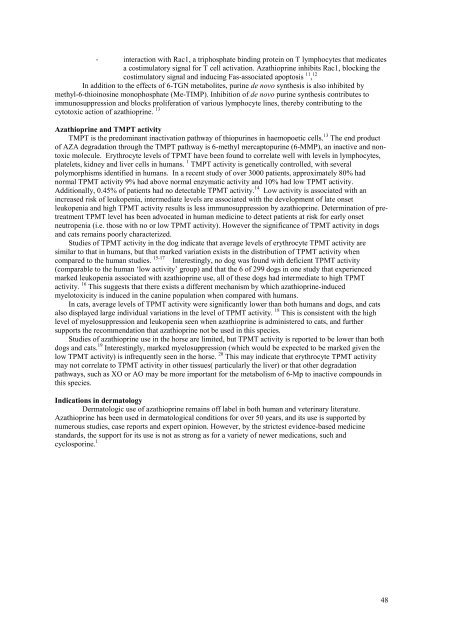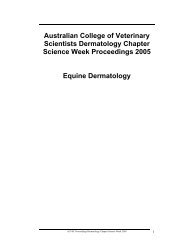Azathioprine and chlorambucil: mechanism of action and use in ...
Azathioprine and chlorambucil: mechanism of action and use in ...
Azathioprine and chlorambucil: mechanism of action and use in ...
You also want an ePaper? Increase the reach of your titles
YUMPU automatically turns print PDFs into web optimized ePapers that Google loves.
- <strong>in</strong>ter<strong>action</strong> with Rac1, a triphosphate b<strong>in</strong>d<strong>in</strong>g prote<strong>in</strong> on T lymphocytes that medicates<br />
a costimulatory signal for T cell activation. <strong>Azathiopr<strong>in</strong>e</strong> <strong>in</strong>hibits Rac1, block<strong>in</strong>g the<br />
costimulatory signal <strong>and</strong> <strong>in</strong>duc<strong>in</strong>g Fas-associated apoptosis 11 , 12<br />
In addition to the effects <strong>of</strong> 6-TGN metabolites, pur<strong>in</strong>e de novo synthesis is also <strong>in</strong>hibited by<br />
methyl-6-thio<strong>in</strong>os<strong>in</strong>e monophosphate (Me-TIMP). Inhibition <strong>of</strong> de novo pur<strong>in</strong>e synthesis contributes to<br />
immunosuppression <strong>and</strong> blocks proliferation <strong>of</strong> various lymphocyte l<strong>in</strong>es, thereby contribut<strong>in</strong>g to the<br />
cytotoxic <strong>action</strong> <strong>of</strong> azathiopr<strong>in</strong>e. 13<br />
<strong>Azathiopr<strong>in</strong>e</strong> <strong>and</strong> TMPT activity<br />
TMPT is the predom<strong>in</strong>ant <strong>in</strong>activation pathway <strong>of</strong> thiopur<strong>in</strong>es <strong>in</strong> haemopoetic cells. 13 The end product<br />
<strong>of</strong> AZA degradation through the TMPT pathway is 6-methyl mercaptopur<strong>in</strong>e (6-MMP), an <strong>in</strong>active <strong>and</strong> nontoxic<br />
molecule. Erythrocyte levels <strong>of</strong> TPMT have been found to correlate well with levels <strong>in</strong> lymphocytes,<br />
platelets, kidney <strong>and</strong> liver cells <strong>in</strong> humans. 1 TMPT activity is genetically controlled, with several<br />
polymorphisms identified <strong>in</strong> humans. In a recent study <strong>of</strong> over 3000 patients, approximately 80% had<br />
normal TPMT activity 9% had above normal enzymatic activity <strong>and</strong> 10% had low TPMT activity.<br />
Additionally, 0.45% <strong>of</strong> patients had no detectable TPMT activity. 14 Low activity is associated with an<br />
<strong>in</strong>creased risk <strong>of</strong> leukopenia, <strong>in</strong>termediate levels are associated with the development <strong>of</strong> late onset<br />
leukopenia <strong>and</strong> high TPMT activity results is less immunosuppression by azathiopr<strong>in</strong>e. Determ<strong>in</strong>ation <strong>of</strong> pretreatment<br />
TPMT level has been advocated <strong>in</strong> human medic<strong>in</strong>e to detect patients at risk for early onset<br />
neutropenia (i.e. those with no or low TPMT activity). However the significance <strong>of</strong> TPMT activity <strong>in</strong> dogs<br />
<strong>and</strong> cats rema<strong>in</strong>s poorly characterized.<br />
Studies <strong>of</strong> TPMT activity <strong>in</strong> the dog <strong>in</strong>dicate that average levels <strong>of</strong> erythrocyte TPMT activity are<br />
similar to that <strong>in</strong> humans, but that marked variation exists <strong>in</strong> the distribution <strong>of</strong> TPMT activity when<br />
compared to the human studies. 15-17 Interest<strong>in</strong>gly, no dog was found with deficient TPMT activity<br />
(comparable to the human ‘low activity’ group) <strong>and</strong> that the 6 <strong>of</strong> 299 dogs <strong>in</strong> one study that experienced<br />
marked leukopenia associated with azathiopr<strong>in</strong>e <strong>use</strong>, all <strong>of</strong> these dogs had <strong>in</strong>termediate to high TPMT<br />
activity. 16 This suggests that there exists a different <strong>mechanism</strong> by which azathiopr<strong>in</strong>e-<strong>in</strong>duced<br />
myelotoxicity is <strong>in</strong>duced <strong>in</strong> the can<strong>in</strong>e population when compared with humans.<br />
In cats, average levels <strong>of</strong> TPMT activity were significantly lower than both humans <strong>and</strong> dogs, <strong>and</strong> cats<br />
also displayed large <strong>in</strong>dividual variations <strong>in</strong> the level <strong>of</strong> TPMT activity. 18 This is consistent with the high<br />
level <strong>of</strong> myelosuppression <strong>and</strong> leukopenia seen when azathiopr<strong>in</strong>e is adm<strong>in</strong>istered to cats, <strong>and</strong> further<br />
supports the recommendation that azathiopr<strong>in</strong>e not be <strong>use</strong>d <strong>in</strong> this species.<br />
Studies <strong>of</strong> azathiopr<strong>in</strong>e <strong>use</strong> <strong>in</strong> the horse are limited, but TPMT activity is reported to be lower than both<br />
dogs <strong>and</strong> cats. 19 Interest<strong>in</strong>gly, marked myelosuppression (which would be expected to be marked given the<br />
low TPMT activity) is <strong>in</strong>frequently seen <strong>in</strong> the horse. 20 This may <strong>in</strong>dicate that erythrocyte TPMT activity<br />
may not correlate to TPMT activity <strong>in</strong> other tissues( particularly the liver) or that other degradation<br />
pathways, such as XO or AO may be more important for the metabolism <strong>of</strong> 6-Mp to <strong>in</strong>active compounds <strong>in</strong><br />
this species.<br />
Indications <strong>in</strong> dermatology<br />
Dermatologic <strong>use</strong> <strong>of</strong> azathiopr<strong>in</strong>e rema<strong>in</strong>s <strong>of</strong>f label <strong>in</strong> both human <strong>and</strong> veter<strong>in</strong>ary literature.<br />
<strong>Azathiopr<strong>in</strong>e</strong> has been <strong>use</strong>d <strong>in</strong> dermatological conditions for over 50 years, <strong>and</strong> its <strong>use</strong> is supported by<br />
numerous studies, case reports <strong>and</strong> expert op<strong>in</strong>ion. However, by the strictest evidence-based medic<strong>in</strong>e<br />
st<strong>and</strong>ards, the support for its <strong>use</strong> is not as strong as for a variety <strong>of</strong> newer medications, such <strong>and</strong><br />
cyclospor<strong>in</strong>e. 1<br />
48
















